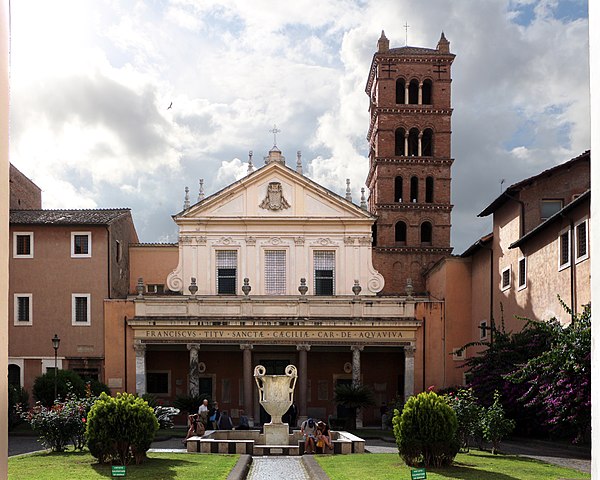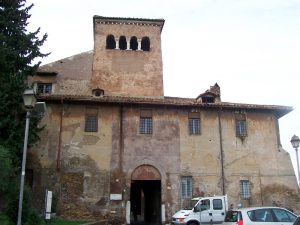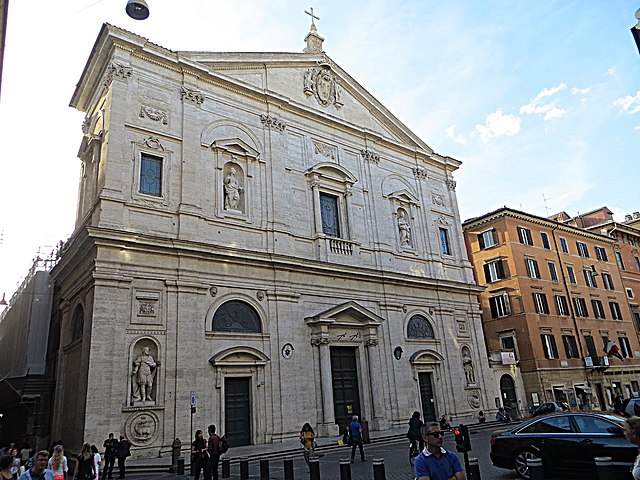Rome is a magical place in so many ways, today we will tell you about three churches that are off the beaten path and definitely worth a visit with our Christian Rome Tour.
The basilica of Santa Cecilia
Photo Credits: Sailko, Santa cecilia in trastevere, esterno 02, CC BY 3.0
It is a Catholic place of worship located in the Trastevere district, outside the historical center of Rome, at Piazza di Santa Cecilia, 22. It has the dignity of a minor basilica.
The Basilica of St Cecilia, patron saint of musicians, stands on the family home of the noblewoman Cecilia, who was martyred around 230 AD. The woman, guilty of having tried to convert her husband Valerian and her brother Tiburtius, was, according to tradition, tortured for three days in the calidarium, in the basement of the church; at the end of the third day, not yet suffocated by the hot vapours, her torturers beheaded her. The Legenda Aurea says that Pope Urban I, who witnessed the torture, buried the martyr’s body among those of the bishops and consecrated the house, turning it into a church. Titulus Caeciliae already in the 5th century, the building became a primitive basilica in the 6th century, thanks to St. Gregory the Great. In 1599, the marble sepulchre was opened by Cardinal Paolo Emilio Sfondrati, and in the cypress casket they found the body of the saint intact, dressed in white and with the mark of her wounds on her neck. The event, which was considered miraculous, prompted Pope Clement VIII to ascertain. In the basement of the church, several rooms have been brought to light that can be traced back to a spa and ancient dwellings, the black and white mosaic floors of which remain.
Basilica dei Santi Quattro Coronati
Another very interesting and little-known church in Rome is the Basilica dei Santi Quattro Coronati is part of a Christian complex located in the Roman district of Celio, on the hill of the same name.
One of the capital’s richest monuments in history, art and spirituality, it is located on the slopes of the Caelian Hill and its grandeur can be appreciated especially when ascending from the Colosseum valley. The impression one gets when crossing its threshold is that of being immersed in an ancient atmosphere suspended in time, far from the chaos and frenetic pace of the modern city.
In the complex you can visit: the Church dedicated to the four Christian Martyrs, the enchanting 13th-century Cloister, the Calendar Room and the Chapel of St. Sylvester, the Hall of the Pentaphores and the marvelous frescoes of the Gothic Hall.
The church takes its name from the tradition of the martyrdom of four Roman soldiers, who affirmed their Christian faith by refusing to worship the god Aesculapius, and five stonemasons from Pannonia employed by the Emperor Diocletian.
Church of Saint Louis of the French
Photo Credits: Mister No, Chiesa di San Luigi dei Francesi – panoramio, CC BY 3.0
Last but not least, we will talk about the Church of Saint Louis of the French.
The French National Church, founded by Cardinal Giulio dei Medici (future Pope Clement VII) in 1518, was completed in 1589 by Domenico Fontana, based on a design by Giacomo della Porta.
Located in the Sant’Eustachio district, a few steps from Piazza Navona and the Pantheon, it is famous for masterpieces by Caravaggio, Domenichino and Guido Reni.
It imposes itself on the square of the same name with a large late Renaissance façade, surmounted by a triangular tympanum with the coat of arms of France, covered with travertine, divided by pilasters in five bays, with three portals and with statues by Pierre Lestache (1758) depicting Charlemagne, Louis IX of France, St Clotilde and St Joan of Valois.
The interior has three naves, punctuated by massive arcades separated by pillars, defined laterally by five chapels on each side, concluded by a deep chancel and covered by an elaborate barrel vault.
The second chapel in the right aisle is dedicated to St. Cecilia and houses frescoes with stories from the life of the saint by Domenichino and an altarpiece of St. Cecilia by Guido Reni.
In the last chapel of the left aisle is the Contarelli Chapel, from the Italianised name of the French cardinal Mathieu Cointrel, which houses three paintings by Michelangelo Merisi, known as Caravaggio, between 1599 and 1602. In homage to the name of the patron, the three canvases are dedicated to St. Matthew and represent: The Calling of St. Matthew, St. Matthew and the Angel and The Martyrdom of St. Matthew. In the vault, frescoes by Cavalier d’Arpino.
On the choir loft above the entrance door is the splendid organ, built by Joseph Merklin in 1881.
The church also houses a number of tombs, including those of Pauline de Beaumont, commissioned by her lover François-René de Chateaubriand, Cardinal François Joachin de Bernis, ambassador to Kings Louis XV and Louis XVI, and Frederic Bastiat, the 19th century liberal economist and writer.
This is just a little blog to provide information for all those interested in finding some special corners of the Roman Christianity melted with art and beauty. For centuries the eternal city was the place where great artists have been commissioned from noble family’s art works inside the roman churches. Faith, art and love were simply melted into each other.




